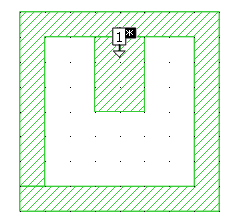A Simplified co-calibrated port is a special case of a co-calibrated port that has the positive terminal attached to the edge of a metal polygon located inside the box and the negative terminal attached to the ground plane through all intervening dielectric layers. A simplified co-calibrated port may be attached to a polygon and then placed on top of another planar polygon. This allows you to create a port in a location without an open polygon edge.
NOTE: In previous releases of Sonnet Software, a simplified co-calibrated port was called an auto-grounded port.
 The simplified co-calibrated port is not as accurate as a normal co-calibrated port. In most circuits, the addition of co-calibrated ports has little influence on the total analysis time of the em job. However, for some circuits, co-calibrated ports may require more time in the de-embedding phase of the analysis. In these cases, you may wish to use simplified co-calibrated ports, which are more efficient but less accurate than co-calibrated ports, since the de-embedding for simplified ports does not take into account the coupling between the ports.
The simplified co-calibrated port is not as accurate as a normal co-calibrated port. In most circuits, the addition of co-calibrated ports has little influence on the total analysis time of the em job. However, for some circuits, co-calibrated ports may require more time in the de-embedding phase of the analysis. In these cases, you may wish to use simplified co-calibrated ports, which are more efficient but less accurate than co-calibrated ports, since the de-embedding for simplified ports does not take into account the coupling between the ports.

Simplified co-calibrated ports can attach to the edge of any metal polygon in the interior of a circuit. There are no restrictions on the loss parameters of the metal used in the polygon. However, along the edge of the metal polygon where the port is attached, em does force the cells to be lossless. For most circuits, this should have little or no effect on the results. If, however, the port is attached to a highly lossy metal polygon, such as a thin-film resistor, the edge cell(s) of that polygon will be made lossless, and the output results may be affected.
You are able to assign negative port numbers to simplified co-calibrated ports but should be aware of some special considerations when doing so. The two simplified co-calibrated ports (+n and -n), although associated by port number, are still de-embedded separately so the coupling between the ports is not de-embedded which can affect the accuracy of your data. Because these ports are de-embedded separately, the port impedance, Z0, only accounts for the impedance of the single line attached to the simplified co-calibrated port since the calibration standard does not include both lines of the differential pair. Lastly, using reference planes in this case may also affect your data, since reference planes are used to de-embed a single transmission line while this configuration creates a differential transmission line.